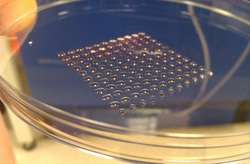
Lots of people use 3-D printers to sculpt plastic. But some are using them to shape cells.
A team of researchers at Heriot-Watt University in Scotland, led by Will Shu, has built a printer that can lay down human stem cells in tiny spheres. Printing human cells has been done before, with bone marrow or skin. Those types of cells, however, are
resilient compared to the more delicate embryonic stem cells.
“The technique will allow us to create more accurate human tissue models which are essential to in vitro drug development and toxicity-testing. Since the majority of drug discovery is targeting human disease, it makes sense to use human tissues.” Shu said in a press release.
The scientists used a printer that has specialized valves, which are adjustable and control the rate at which the cells are released. That allowed them to put the stem cells where they are needed and keep them intact.
Stem cells are the building blocks of organs and tissues; they are “generic” cells that can become specific kinds when exposed to the right conditions. But one of the difficulties with them is that they are delicate; if the printer
doesn’t treat them gently they will lose their ability to differentiate into various cell types.
Shu and his team built a printer that forms the cells into tiny spheres, while keeping them alive.
In the longer term, the printer could help build organs for transplants or repair. Since the printer can put stem cells in a three-dimensional pattern, it could build a small “patch” for a heart or kidney that would be made from stem cells cloned from the patient.
Shu’s team worked in partnership with Roslin Cellab, a company that plans to commercialize the technology.
A team of researchers at Heriot-Watt University in Scotland, led by Will Shu, has built a printer that can lay down human stem cells in tiny spheres. Printing human cells has been done before, with bone marrow or skin. Those types of cells, however, are
resilient compared to the more delicate embryonic stem cells.
“The technique will allow us to create more accurate human tissue models which are essential to in vitro drug development and toxicity-testing. Since the majority of drug discovery is targeting human disease, it makes sense to use human tissues.” Shu said in a press release.
The scientists used a printer that has specialized valves, which are adjustable and control the rate at which the cells are released. That allowed them to put the stem cells where they are needed and keep them intact.
Stem cells are the building blocks of organs and tissues; they are “generic” cells that can become specific kinds when exposed to the right conditions. But one of the difficulties with them is that they are delicate; if the printer
doesn’t treat them gently they will lose their ability to differentiate into various cell types.
Shu and his team built a printer that forms the cells into tiny spheres, while keeping them alive.
In the longer term, the printer could help build organs for transplants or repair. Since the printer can put stem cells in a three-dimensional pattern, it could build a small “patch” for a heart or kidney that would be made from stem cells cloned from the patient.
Shu’s team worked in partnership with Roslin Cellab, a company that plans to commercialize the technology.
